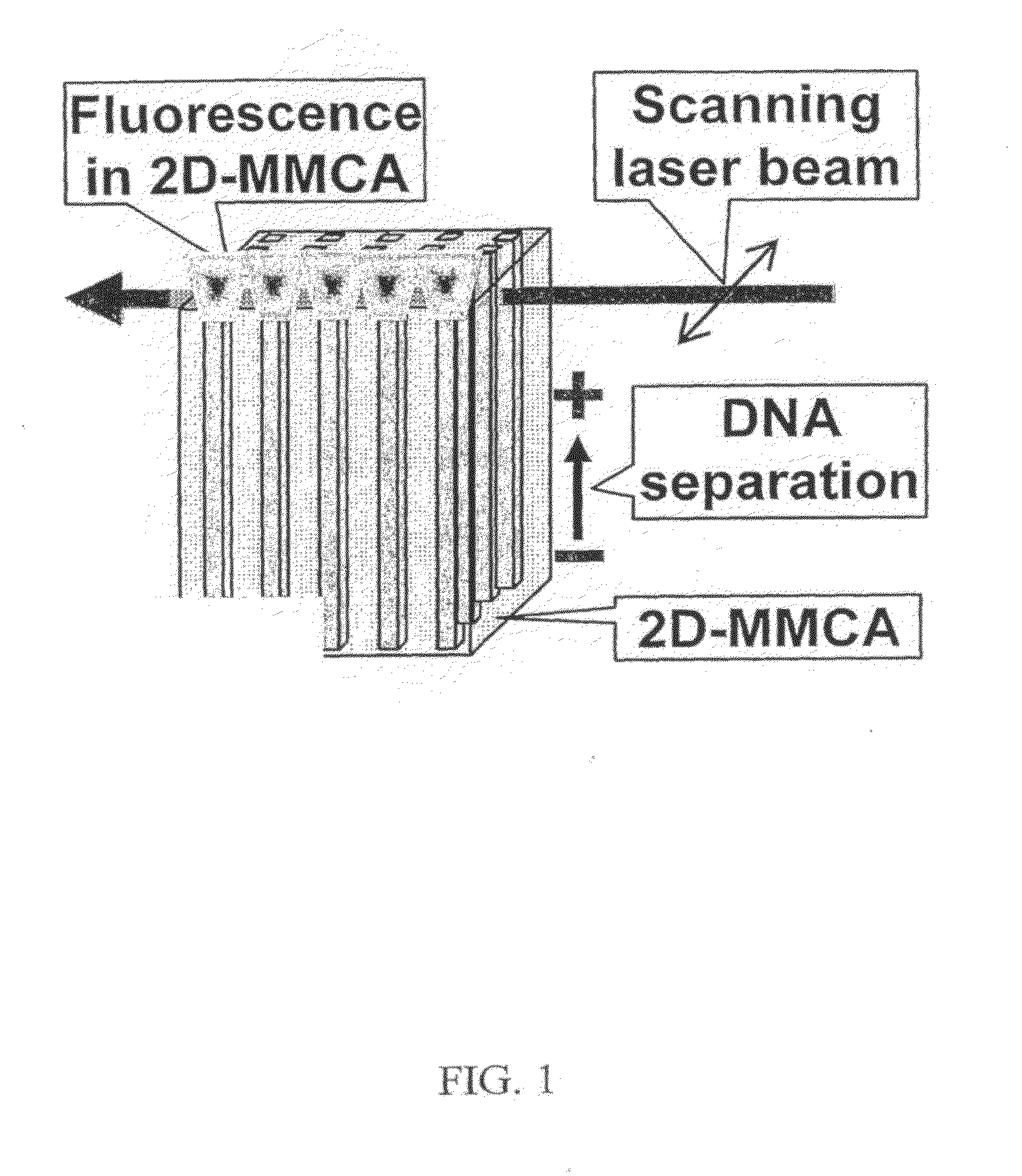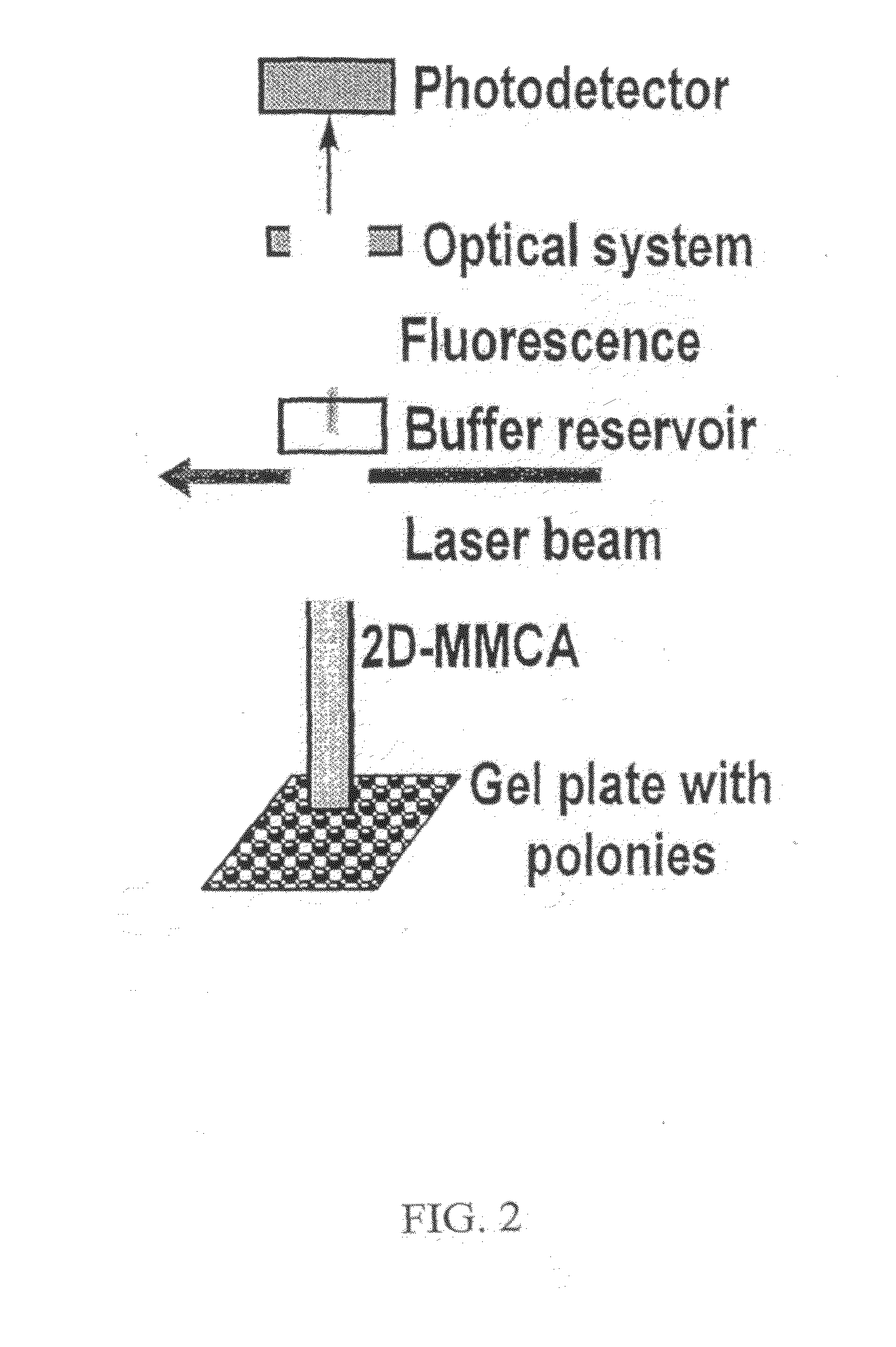Massively Parallel 2-Dimensional Capillary Electrophoresis
- Summary
- Abstract
- Description
- Claims
- Application Information
AI Technical Summary
Benefits of technology
Problems solved by technology
Method used
Image
Examples
example i
Demonstration of PCR Amplification in Polonies
[0228]This example demonstrates the reliable reproduction of the “polony” method consistent with previously reported studies. Specifically, PCR amplification of gel-immobilized 500 base pair and 1,000 base pair DNA fragments (target: 1.5 efficiency in linear PCR region) and a protocol for cycle-sequenced dideoxynucleotide-terminated extension in polonies are described.
[0229]A. ddNTP-Terminated Extension Product of Cycle-Sequencing Reaction
[0230]After reliable and reproducible polony growth has been achieved, a protocol for conducting the Sanger cycle-sequencing reaction on strands of extended gel-immobilized primers (JCF-AC or A) is performed. After polony amplification and washout, the immobilized dsDNA is denatured and the unattached DNA strand is removed by incubating the plate in a 70° C. denaturing buffer (70% formamide) for 15 min and performing electrophoresis in 0.5× TBE (90 mM Tris / 64.6 mM boric acid / 2.5 mM EDTA, pH 8) with 42% ...
example ii
Fabrication of an MMCA
[0237]This example describes the manufacture of a linear 64-lane and 96-lane MMCAs with 30 μm and 50 μm square capillary cross section, wherein the characterization of MMCA illumination and fluorescence detection is performed from the array top.
[0238]A. Single-side MMCA illumination demonstrating an approximate 80% transmission of the laser beam through the MMCA using fluorescent detection from the top of the MMCA.
[0239]Using the capillary drawing facility at SUNY Sensor CAT a borosilicate glass 55-lane and 100-lane linear MMCAs with square 30 μm and 50 μm capillary cross section and 100 μm and 60 μm array pitch is fabricated. The arrays are filled with separation media containing fluorescent dyes and illuminated from the side. The uniformity of the array illumination is measured by detecting the distribution of fluorescence in the MMCA's capillaries. See FIG. 5.
[0240]In order to carry out measurements of fluorescence excited in the MMCA, a custom fiberized pre...
example iii
Addressable Cassettes: Gel-Immobilized PCR and Sequencing Reactions
[0242]This example describes a method to perform polymerase chain reaction amplification and sequencing on addressable cassettes compatible with 2D-MMCA. In the following steps, a Starter Kit kindly offered upon request by the Church group is used. The kit includes 800 bp linear template dsDNA (pCR2-1-TABS3-D5), Acrydite-modified forward primer (JCF-AC), free reverse primer (JCR-UN), Cy3-labeled sequencing primer, as well as the gel slides ready for PCR and slides on which PCR has been already conducted. The kit is used for comparing with and controlling the progress in developing our optimized protocol.
[0243]A. Casting the Gel
[0244]Casting the gel in the cassettes is done first with the following general protocol:[0245]1. Frames with thin 5×7 mm electrodes (i.e., for example, aluminum, gold, etc) attached to glass or acrylic plastic substrate are pre-treated with Bind Silane by incubating them ˜1h in a coating solut...
PUM
| Property | Measurement | Unit |
|---|---|---|
| Thickness | aaaaa | aaaaa |
| Thickness | aaaaa | aaaaa |
| Length | aaaaa | aaaaa |
Abstract
Description
Claims
Application Information
 Login to View More
Login to View More - R&D
- Intellectual Property
- Life Sciences
- Materials
- Tech Scout
- Unparalleled Data Quality
- Higher Quality Content
- 60% Fewer Hallucinations
Browse by: Latest US Patents, China's latest patents, Technical Efficacy Thesaurus, Application Domain, Technology Topic, Popular Technical Reports.
© 2025 PatSnap. All rights reserved.Legal|Privacy policy|Modern Slavery Act Transparency Statement|Sitemap|About US| Contact US: help@patsnap.com



